Sky Islands Rise from Desert Seas
The basin and range geography that created all the deserts of North America, in the Sonoran created a chain of 10,000-foot-tall (3,048 m) mountains surrounded by low desert basins that help account for the extraordinary ecological diversity of the Sonoran Desert. One of the most striking mountains is the 7,730-foot-tall (2,356.10 m) Baboquivari in southern […]
Unseen seas
The reserve of water that is thought about least often is the one you cannot see. Billions of tonnes of the stuff exists just below our feet and has a vital role in the Earths living and non-living systems. As we have seen, the Earth gets steadily hotter with depth, and soon reaches the boiling […]
The sea, the sea
The deep and surface ocean currents carry far more than heat around the world. They mean that salt, oxygen and other chemicals are distributed more or less evenly around the Earths oceans. However, many of the Earths most important water masses are seas rather than oceans. What they lack in size, they make up for […]

Ice Sheets and Sea Ice
The ice sheets of Antarctica and Greenland are huge plates of ice, thousands of meters thick in the central areas, resting on large land masses. The Greenland Ice Sheet has an area of 1.7 million km2 (about 670,000 mi2) and occupies about seven-eighths of the entire island of Greenland (Figure 17.11). The only land exposed is a narrow, mountainous coastal strip. […]
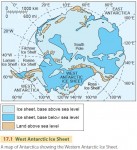
Ice Sheets, Sea Ice, and Global Warming
What effects will global warming have on the Earth's ice sheets and sea ice? In general, global climate models predict two types of changes in the Earth's ice sheets. First, warming on land and ocean will cause the melting and thinning of the edges and ice shelves of the Greenland and Antarctic ice caps. This will increase sea level. Second, warming […]

The Aral Sea
East of the Caspian Sea, astride the former Soviet republics of Kazakhstan and Uzbekistan, lies an immense saline lake—the Aral Sea. Fed by meltwaters of high glaciers and snowfields in the lofty Hindu Kush, Pamir, and Tien Shan Ranges, the lake endured through thousands of years as an oasis for terrestrial and aquatic wildlife deep in the heart of the central […]
Economic Geographies of the Sea
Finally, economic geographers as well are beginning to direct their attention to the ocean. Countless local and national economies are driven by the tourism sector and, within the tourism sector, a wide range of activities involve tourists embracing the ocean, whether from the shore, a ship, the surface, or beneath the waves. Economic gain is also constructed in the ocean […]
Environmental Geographies of the Sea
Just as historically there has been little cultural geography of the sea, similarly few human geographers until recently have focused on the ocean as a space of nature. To some extent, this likely is because, until recently, it was believed that humans could do little to influence the condition of the marine environment or the status of marine resources. Prior […]
Cultural Geographies of the Sea
While contemporary studies of the political geography of the sea can draw upon a long history of political geographers studying maritime conflict, the study of marine issues is quite new in cultural geography. Of course, there always have been marine cultural geographies; seafaring and fishing communities invariably display distinct cultural formations that reflect and impact the surroundingmarine environment. Historically, […]
Political Geographies of the Sea
Historically, when human geographers have studied the ocean, they most often have looked to the sea as a space of politics and, in particular, as an arena for geopolitical conflict. The ocean has been viewed as a space in which the forces of land based states meet as each attempts to control crucial areas of the sea (e.g., choke points […]
Emergent Geographies of the Sea
These epistemological shifts, in turn, have led to new areas of research in the human geography of the ocean. In the remainder of this section, four areas of human geography are reviewed: political, cultural, environmental, and economic geographies of the sea.
A Sea Change in Epistemology
In recent decades, each of these barriers to human geographic research on the ocean has been challenged by broad reaching shifts in social thought. Turning first to the barrier of state centrism, since the 1970s the rise of globalization studies has led to the emergence of a number of perspectives that challenge the prevailing view of the world as a […]
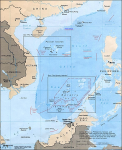
South China Sea
THE SOUTH CHINA Sea covers an area of 1.35million square mi (3.5 million square km) bordered by he People's Republic of CHINA, the Republic of China (TAIWAN), the PHILIPPINES, MALAYSIA, BRUNEI, INDONESIA, SINGAPORE, THAILAND, CAMBODIA, and VIETNAM. The South China Sea is a marginal sea, which means that it is part of the PACIFIC OCEAN but at the same time separated from […]

seamounts
SEAMOUNTS ARE MOUNTAINS more than 3,281 ft (1,000 m) high that rise from the seafloor and do not break the water's surface. Some seamounts occur thousands of meters beneath the ocean surface, while others are only dozens of feet from the surface. Seamounts vary in form as well—seamounts whose tops have been truncated by wave action resemble volcanic cones. Some seamounts are […]
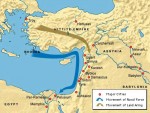
Sea Peoples
SEA PEOPLES ARE one of the populations of the ancient world who vigorously shaped the cultural landscapes in the eastern Mediterranean and adjacent lands. Sea Peoples were active from EGYPT to GREECE and as far as Sardinia and Corsica, and they reached the apex of their activity around 1200 B.C.E. They were a people or clans of seafarers who invaded eastern Anatolia, […]
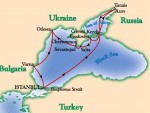
Sea of Azov
THE SEA OF AZOV is an arm of the BLACK SEA, extending from the mouth of the River Don to the Kerch Strait. It covers 14,520 square mi (37,230 square km) and is 226 mi (365 km) east to west, and 110 mi (175 km) north to south. RUSSIA borders the sea to the east, with UKRAINE to the north […]
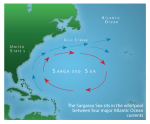
Sargasso Sea
THE SARGASSO SEA is located in the North ATLANTIC OCEAN. The area of the sea is found between 20 degrees N and 35 degrees N latitude and 30 degrees W and 75 degrees W longitude—the hump extending northward of BERMUDA. This is also known as the “horse latitudes.” The Sargasso Sea, relatively calm and motionless, is unique, as it has no […]

Red Sea
THE RED SEA CONNECTS the MEDITERRANEAN SEA to the INDIAN OCEAN via the Suez Canal. It lies in the Great Rift Valley between Africa and the Arabian Peninsula. EGYPT, SUDAN, ERITREA, and DJIBOUTI border it to the west, while ISRAEL is to the north and JORDAN, YEMEN, and SAUDI ARABIA are the to the east. Scientists believe it was formed 20 […]

Mediterranean Sea
THE TRANSLATION of its Latin name (“in the midst of land”) indicates that the Mediterranean Sea is located between the landmasses of Europe, Asia, and Africa. Some students of geography may view the Mediterranean as a physical separation between Europe and Africa. Nothing could be further from the truth. The Mediterranean, in fact, has been […]

Law of the Sea
THE LAW OF THE SEA is a compilation of international and national laws regulating the demarcation of areas of maritime jurisdiction appertaining to maritime states. While its origins were military and defensive today it focuses on respective rights of resource exploitation—oil and minerals as well as fisheries. The importance of international innocent passage via geopolitical […]
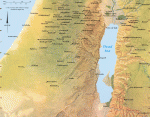
Dead Sea
THE DEAD SEA IS a 390-square-mi (1,010-squarekm) salt lake located on the borders of PALESTINE, ISRAEL, and JORDAN. It is the lowest water point in the world, and its coast, at 1,292 ft below sea level (-395 m), is the lowest dry point on Earth. The lake is divided into two unequal parts by el-Lisan […]
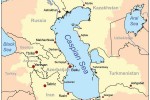
Caspian Sea
THE CASPIAN SEA IS ONE of the world's largest bodies of water, situated in a depression between RUSSIA, KAZAKHSTAN, TURKMENISTAN, IRAN, and AZERBAIJAN. It is unique among the world's inland seas in that it is completely isolated from the rest of the global ocean and has a distinctive continental climate which gives the area extremes […]

Caribbean Sea
THE CARIBBEAN SEA is a suboceanic BASIN in the western ATLANTIC OCEAN. The sea covers just over 1 million square miles (2.6 million square km) and contains numerous islands. The islands, which vary greatly in size, cover some 91,000 square mi (235,688 square km). CUBA is by far the largest at 44,000 square mi (113,959 […]

Black Sea
THE BLACK SEA IS a body of salt water that stretches 630 mi (1,014 km) from east to west. TURKEY faces its southern shore, BULGARIA and ROMANIA lie west of the Black Sea, and UKRAINE, RUSSIA, and GEORGIA border it to the north, northeast, and east, respectively. The Black Sea stretches 330 mi (530 km) […]
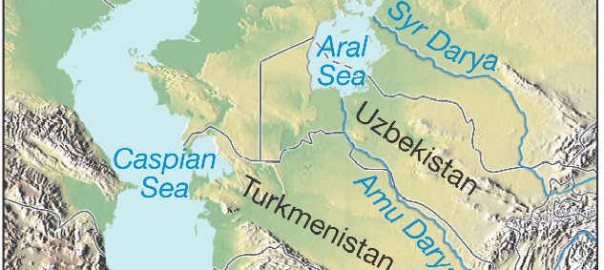
Aral Sea
THE ARAL SEA (Aral'skoye More) is one of the world's largest lakes or inland seas. It is located to the east of the CASPIAN SEA in the Central Asian republics of Kazakhstan and Uzbekistan. The region is arid, with the Karakum Desert lying to the west of the Aral Sea and the Kyzylkum Desert to […]
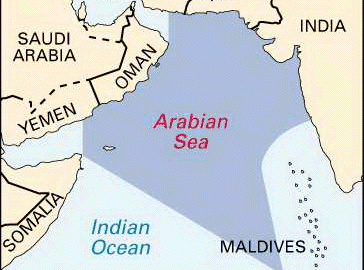
Arabian Sea
THE ARABIAN SEA covers approximately 1,491,000 square mi (3,862,000 square km) and is located between the Arabian and Indian peninsulas in the northwestern area of the INDIAN OCEAN, bounded by INDIA, PAKISTAN, IRAN, OMAN, YEMEN, and the HORN OF AFRICA. The Arabian Sea has been the historic trade route from Occident to Orient since the […]
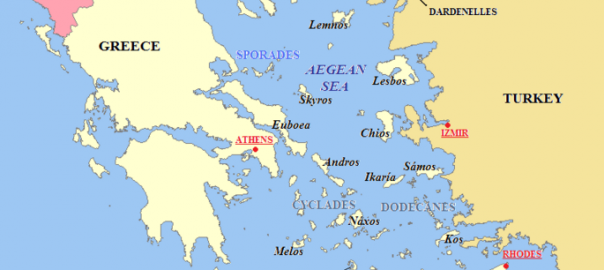
Aegean Sea
THE AEGEAN SEA is an arm of the MEDITERRANEAN SEA, located between the Greek peninsula to the west and TURKEY to the east. The Aegean is connected through the Dardanelles, the Sea of Marmara, and the Bosporus with the BLACK SEA, while the island of Crete is considered to be the southern boundary. In all, it […]
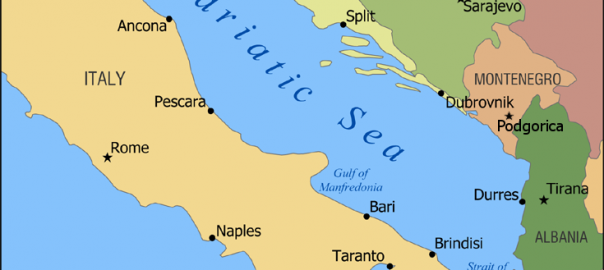
Adriatic Sea
THE ADRIATIC SEA (in Italian “Mar Adriatico,” in Serbian “Jadransko more”) is a northwest-to-southeast arm of the MEDITERRANEAN SEA. The sea separates the Italian peninsula from the Austro-Hungarian, Montenegrin, and Albanian littorals, and the Italian Apennine Mountains from the Balkan Dinaric Alps. The western coast is Italian and the eastern comprises Slovenia, Croatia, Bosnia and […]